Minolta XG-M SLR
Introduction
The Minolta XG-M is a 35 mm single-lens reflex camera, or SLR. The SLR
is the most versatile type of still camera, and is the type most used by
professional photographers. In an SLR, the viewfinder image goes through
the main lens, so the photographer can see the same image that will appear
on the film. If the main lens is changed to a different focal length, the
photographer will automatically see the effect of that change. With an
SLR, unlike rangefinder cameras, there is no worry about parallax errors
in closeup shots. In order to "share" the main lens with the film, a flip-up
reflex mirror is used. The mirror is located behind the main lens and reflects
the light from the lens into the viewfinder optics.
The viewfinder optics consists of a focusing screen, a pentaprism, and
viewfinder lenses. The focusing screen is used for focusing the image.
The focusing screen is located the same distance away from the lens as
the film. Thus, when the image is in focus on the focusing screen, it will
also be in focus on the film. The image from this screen is reflected up
through the pentaprism on top of the camera, back through the viewfinder
lenses, and out to the viewfinder. When the camera's shutter is released
to take a picture, the reflex mirror flips up, allowing light to go back
through the shutter, and then to the film. During this time, the image
to the viewfinder is blocked. For short exposures, this appears as a brief
wink, but for longer exposures, it's a long blackout. This also means that
when taking a flash photograph, the flash cannot be seen through the viewfinder,
and the photographer may not be aware of whether or not the flash went
off, unless he keeps both eyes open.
In SLR cameras, the shutter is located in front of the film. It is called
a focal plane shutter, since it is just in front of the focal plane
of the lens. Non-SLR cameras, like point-and-shoots, usually have the shutter
built into the lens. The focal plane shutter must be as big as the
film frame, so it tends to be larger and more complicated than in-lens
shutters. To operate at high shutter speeds, the focal plane shutter turns
into a moving narrow slit. The faster the shutter speed, the narrower the
slit. This has the side effect that can cause rapidly moving round objects
to appear oblong at high shutter speeds. Focal plane shutters tend to have
very fast shutter speeds compared to in-lens shutters. The XG-M has a maximum
shutter speed of 1/1000 of a second.
Because the photographer must view the image through the main lens,
its opening , or aperture, must stay wide open while viewing and focusing
to provide a bright image. However, the aperture must close to its correct
setting when taking the picture. The SLR camera has a mechanism to close
the aperture only when the picture is being taken. The depth of focus is
affected by the lens opening. To view the depth of focus, the camera has
a feature to manually close the aperture to its current setting.
To determine the correct combination of shutter speed and aperture opening
to take a properly-exposed picture, SLRs often have exposure control systems.
Some cameras are completely manual and rely on the use of an external light
meter. Other cameras have built-in light metering and exposure control
systems. These require light sensors to measure the amount of light available
on the subject. The XG-M uses a through-the-lens system that measures the
amount of light that comes in through the lens. Photocells are mounted
on the viewfinder's pentaprism and are most sensitive to the light in the
center of the viewfinder image. This is called center-weighted.
The XG-M uses a type of automatic exposure system which is known as
aperture-priority. The photographer manually sets the aperture according
to the desired depth-of-focus, and the camera automatically sets the shutter
speed to provide the proper exposure. If the camera picks a shutter speed
that is too slow, the lens must be manually opened wider.
One advantage of the SLR is that the lenses can be easily removed and
interchanged. It can take a wide range of lenses from extreme wide angle
to extreme telephoto. There is almost no limit to the type and range of
lenses that can be used. The SLR can also be adapted for use on microscopes,
telescopes, or other optical instruments. Also, filters can be installed
on the lenses. Filters can change the amount of light entering the lens.
For cameras like the XG-M that use through-the-lens metering. the system
automatically compensates for the filter in most cases. Relatively inexpensive
teleconverters can be used to multiply the focal length of existing lenses,
at the expense of lens speed. Closeup lenses can be attached to the front
of lenses, which reduces their minimum focus distance.
The disadvantage of SLRs is that they tend to be more expensive, bigger,
and heavier than most point-and-shoot cameras. The complicated shutter
and mirror mechanism tends to be noisier than simple in-lens shutters.
Also, manual focus cameras are more difficult to use for catching action
shots, especially where the subjects are constantly moving. Auto-focus
SLRs are available, but they are expensive. Thus for casual use, hiking
pictures, and taking pictures of children playing, SLRs are at a disadvantage.
However, for the ultimate in flexibility and creative control for serious
photography, SLRs are unsurpassed.
Specifications
-
Single-lens reflex camera back, vintage 1981.
-
Manual focus.
-
Horizontal cloth focal plane shutter, electronically-controlled.
-
Aperture-priority, automatic shutter speed.
-
Shutter speed range: bulb, 1 sec to 1/1000 sec.
-
Electronic flash shutter speed: 1/60 sec.
-
Self-timer
-
Hot flash shoe
-
Manual wind, rewind, ASA setting.
-
Exposure adjust +/-2 stops.
-
Minolta Rokkor lens, f1.4 X 50 mm, bayonet mount.
-
Zoom lens: Vivitar F3.8, 75-205 mm with macro.
Parts of the Camera
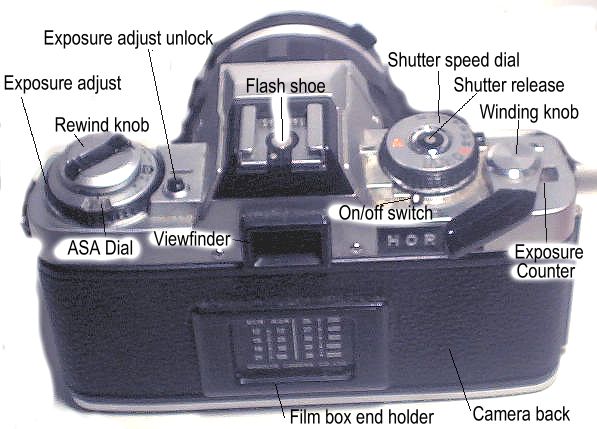
-
Set the film speed with the ASA dial. Lift up on the black Exposure Adjust
Ring and turn it until the film's ASA value appears in the window. The
ASA number is written on the film box and indicates the film's sensitivity.
The higher the ASA number, the more sensitive, or faster, the film. The
faster the film, the more it costs, and the grainier the picture. An ASA
of 100 is good for outdoor shots or for high quality shots. 400 is good
for indoor shots. 200 is a good all-purpose film speed. Greater than 400
is for special purposes, like sports photography or low-light photography,
but it tends to be very grainy.
-
To remember what kind of film is in the camera, you can tear off
the end of the film box and put it in the holder at the back of the camera.
The holder has a table that shows the conversion between ASA and DIN (European)
numbers.
-
The Exposure Adjust Knob will allow up to 2 stops under or over-exposure
using the automatic shutter. It should normally be set at the black 0.
Push the Exposure Adjust Unlock Button to unlock the dial and turn it to
the + side for over-exposure or the - side for under-exposure. Don't forget
to turn it back to 0.
-
At the top of the camera is a hot shoe for the flash unit. A hot shoe flash
unit needs no other wires to trigger the flash. The flash must be fully
inserted in the shoe to contact the electrode in the center. A non-hot
shoe flash needs a PC cable to be plugged into the PC flash socket on the
front of the camera (see below).
-
In the center of the Exposure Adjust Knob is the Rewind Knob. It is used
to manually rewind the film. If the film is tight, the knob turns when
the film is advanced, which is a good indicator that the film is advancing
properly. To tighten the film, wind the knob clockwise carefully until
you feel some resistance. Don't over-tighten, or you could strip the sprocket
holes in the film. When rewinding an exposed roll, push the Rewind Release
Button (see below), then turn the Rewind Knob clockwise rapidly. Flip up
the crank handle on the knob to allow turning it more rapidly. If the knob
is hard to turn, don't force it. You could tear the film. Make sure the
Rewind Release Button has been pushed in all the way. When the resistance
to turning the knob suddenly decreases, the film has released from the
takeup spool. Keep winding the knob several more times to bring the film
all the way into the film cassette. Turning the knob to see if it tightens
is another way to see if film has been loaded into the camera.
-
Pulling up on the Rewind knob opens the film back to allow changing film
(see below).
-
The following pertains to the viewfinder:
-
The viewfinder shows the shutter speed in lights on the side of the screen.
LEDs next to the shutter speed numbers indicate the correct shutter speed.
If the camera is in automatic mode, this will be the actual shutter speed.
-
If the exposure requires a shutter speed that is too fast or too slow for
the camera, arrows will light up at the top or bottom of the shutter speed
readout. The indicator at the top is the over-range indicator. When this
is lit, the automatic shutter will lock to prevent over-exposure.
-
The under-range indicator is at the lower end of the scale. If it is lit,
indicates a shutter speed longer than 1 second is needed. The camera cannot
automatically control an exposure longer than 1 second accurately, so it
will not be able to make a correct exposure.
-
If the camera is in manual mode, the M indicator will light up in the viewfinder
at the bottom right. The shutter speed LEDs will indicate the correct shutter
speed as determined by the camera's metering system. You can use this information
to set the shutter speed or disregard it.
-
The camera can be used as a light meter to see what the appropriate shutter
speed settings are for different objects or scenes. Put the desired object
in the center of the screen and note the shutter speed. The shutter can
them be manually set to this, so that this object will have the proper
exposure.
-
At the bottom of the screen is a small window that allows seeing the f-stop
setting on the lens.
-
The center of the screen has a split-image focus indicator. When the top
and bottom of the split-image are aligned, the object is in focus. Around
the split image is a ring, called a micro-prism field, that breaks up into
polygons when the object is out of focus. The rest of the screen is a matte
surface that shows a sharp image when in focus.
-
The camera's exposure control senses the whole screen, but is most heavily
weighted around the center of the screen. If you want the exposure to be
brighter (over-exposed) or darker (under-exposed) than the center
of the screen, use the Exposure Adjust knob above. Be careful when aiming
the camera at bright lights or large dark areas. The camera can be fooled
and will give under or over exposures. When shooting a backlit subject,
the Exposure Adjust can be used to brighten up the subject to see it better
or darken it to become a silhouette.
-
The shutter release is the button in the center of the shutter speed dial.
Touching or pushing the button partway down turns on the shutter speed
indicator in the viewfinder. Pushing it all the way triggers the shutter.
The camera must be cocked (see below) and powered on. In automatic exposure
mode, if the shutter speed is out of range, the shutter will not release.
Change the aperture setting until the shutter speed is back in range.
-
At the back of the shutter speed knob is the power on/off indicator. Turn
the camera off when not in use to save battery life.
-
The Shutter Speed Dial controls the shutter speed. For normal automatic
operation, leave it in the "A" position. The shutter speed will adjust
automatically to provide the correct exposure. You can see the shutter
speed in the viewfinder. If the shutter speed is too slow to take a steady
pictures without blurring, open the aperture. If the shutter speed is too
fast, close the aperture.
-
Use the manual settings only if necessary. Each successive shutter speed
setting is a factor of 2 different from the next one. The fastest shutter
speed is 1/1000 of a second. This is useful for stopping fast action or
for shooting handheld with a long focal length lens. With a normal 50 mm
lens, the lowest handlheld shutter speed without blurring is about 1/125
of a second. Higher focal lengths require faster shutter speeds.
-
One time a manual shutter setting is absolutely necessary is when using
a flash. An electronic flash is very brief, so the shutter must stay fully
open when the flash goes off. A focal plane shutter works by turning into
a narrow moving slit at high shutter speeds. Only at low shutter speeds
is the shutter fully open at any one time. On this camera, it is 1/60 of
a second, which is indicated by a red 60. If you use a faster shutter speed
than that with an electronic flash, parts of the frame will be unexposed.
If you use a slower shutter speed, you can get "ghosting" from moving of
the camera or objects after the flash has gone off.
-
The longest timed exposure is 1 second. To take a longer exposure, use
the B setting, which is the Bulb setting. The shutter will stay open for
as long as the shutter release button (or remote shutter release) is pressed.
There is a limit to how long it will stay open, but it is at least several
seconds. Long time exposures should only be used with a tripod or other
firm camera mount.
-
The film winding knob advances the film and cocks the shutter. After each
shot, turn the knob counter-clockwise until it won't turn any more. Once
it stops, do not try to force it any further. The lever will stay in a
partway-out position, which allows for more rapid successive shots. Once
the camera is cocked, it can take 1 shot. If the camera is not cocked,
pushing the shutter release will do nothing. If you are not going to use
the camera for awhile, leave the camera in an uncocked state to preserve
the shutter springs. (The camera does not support multiple exposures, but
there is a trick for doing it if necessary.)
-
The Exposure Counter window shows which frame the film is on. The first
few frames take in the leader, but 1 or 2 frames may be unusable. Don't
rely on this for important shots. The first reliable frame is #1.
The red numbers indicate the most common film exposure lengths.
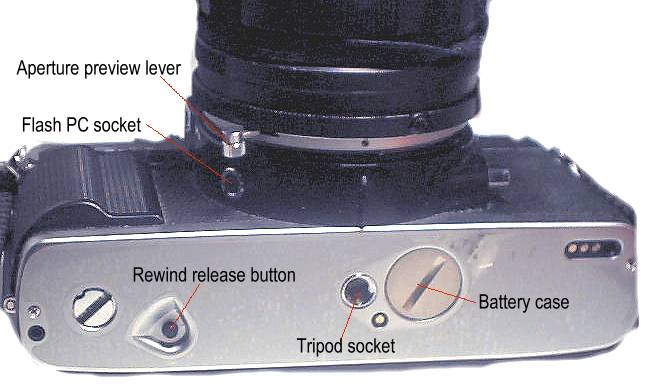
-
To get to the bottom of the camera, remove the camera case.
-
The Rewind Release button releases the film sprocket roller and allows
the film to be rewound.
-
Trick: To do multiple exposures, after taking the first exposure, tighten
the rewind knob so that the film is tight and won't move. Hold the rewind
knob still to keep the film from moving. Push the Rewind Release button.
Cock the shutter. You can now take another picture. This method is not
very accurate, so don't rely on it for precise alignments.
-
In the middle of the bottom is a tripod socket.
-
The battery case cover unscrews with a coin. When you pull it out, a battery
holder comes out, which holds 2 type 357 batteries. Note the polarity before
replacing the batteries (the small button end of the batteries face the
cover).
-
The other contacts and things on the bottom are for an optional motor drive.
-
Near the bottom of the base of the lens mount is an electrical socket for
flashes that need a PC cable. (The flash unit comes with such a cable for
use with cameras that do not have hot shoes.)
-
On the base of the lens is a small lever that closes the aperture to its
current setting. This allows previewing the scene to see the effect of
the aperture setting on the depth of focus.
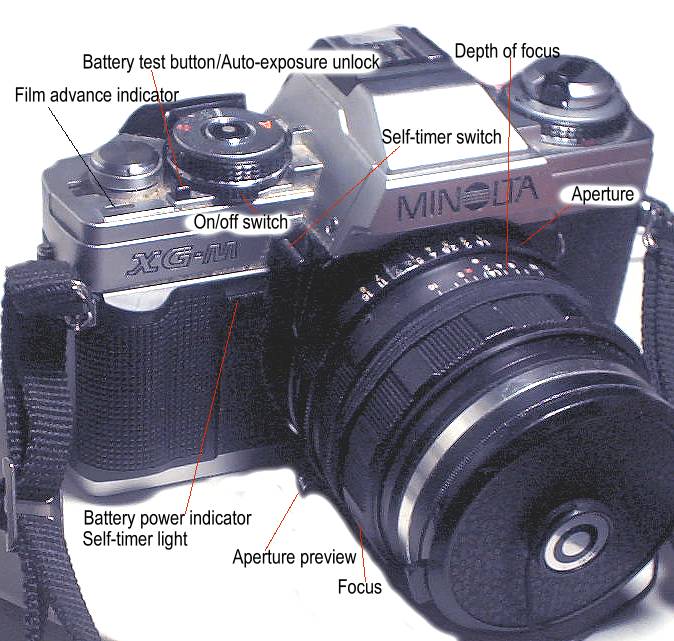
-
On top of the camera in front of the Film Winding knob is the Film Advance
Indicator. When the film is properly loaded and advancing correctly, an
orange bar will appear in this window and gradually move across it. Otherwise,
the window will be blank.
-
Next to the Shutter Speed dial is a dual purpose button. When pressed down,
it tests the batteries. If the batteries are good, the red Battery Power
Indicator light will light up. Also when pressed down, it unlocks the shutter
speed dial from its automatic setting.
-
The Self-Timer switch is used to delay the shutter release by 10 seconds.
Pull the switch up. After the shutter is pressed, the combination Battery
Power Indicator/Self-Timer Light will start flashing. The flash rate will
increase just before the shutter releases. Using the self timer is a good
way to take long time-exposure tripod shots, since it gives time for the
camera to stop shaking after the shutter release has been pressed.
-
In front of the Shutter Speed dial is the On-Off Switch. Flip this to turn
the camera power on or off.
-
On the lens are two rings: the front one for changing the focus, the back
one for changing the aperture. The focus ring is marked with distance in
feet and meters. The white arrow points to the focus distance. The red
R indicates the infrared focus point when using infrared film. The Depth
of Focus indicator shows which range of distances on the focus ring will
be in focus for different apertures. The smaller the aperture, the wider
the depth of focus.
-
The Aperture ring sets the lens opening, called f-stops. On this lens,
the largest opening is f1.4. A lens with a low f-stop is considered a fast
lens. An f1.4 lens is very fast. The smallest is f16. The f-stop
is the ratio of the focal length of the lens divided by the diameter of
the aperture. For example, with a focal length of 50 mm, an opening of
25 mm means an f-stop of f2. The lower the f-stop, the wider the lens opening
and the more light that is passed through the lens. Each f-stop increment
lets in twice as much light as the one below it. Each f-stop increment
can be traded off with 1 shutter speed increment when setting the exposure.
-
Quick rule of thumb: on a sunny day, set the aperture to f16, then set
the shutter speed to the ASA rating of the film.
-
The depth of focus, which is the range of distances that are in focus,
increases with smaller lens openings. The aperture should be set to give
the desired depth of focus and still have adequate shutter speed to prevent
blurring. Turning the aperture ring has no effect on the visible image.
The lens is kept at full open until the shutter is released. The lens closes
to its set aperture setting when the shutter is open, then opens up again.
The aperture preview lever or button are used to close the aperture while
looking through the lens to see its effect on the depth of focus.

-
To remove the lens, push the Lens Release button and turn the lens counter-clockwise
until it stops. When the red dot on the side of the lens, which indicates
the lens removal/installation point (see below), is straight up, the lens
can be pulled straight forward and removed. Lens installation is the reverse.
-
The Remove Shutter Release socket is a screw-in mount for attaching a remote
shutter release cable. A remote release cable is typically used for tripod-mounted
shooting, especially for Bulb time exposures. It allows tripping the shutter
without touching the camera and blurring the image.
-
Not every lens has an aperture preview lever. The Aperture Preview button
causes the lens aperture to be closed to its current setting.
-
The camera strap has a spare battery holder and viewfinder cap on it. The
viewfinder cap is for covering the viewfinder and preventing light from
entering the viewfinder and fooling the exposure system when taking low-light
pictures remotely on a tripod.
-
Also mounted on the strap is a lens hood. This is used to keep sunlight
off the front of the lens when shooting towards the sun. Without the lens
hood, sunlight can cause lens flare. The lens hood also helps protect the
front of the lens from impact and from being touched accidentally.
-
Filters can be screwed onto the front of the lens. Currently a skylight
filter is in place. This filters out ultraviolet light which can cause
a blue cast in shadows in outdoor pictures. It does not reduce the amount
of light entering the lens. Other types of filters can reduce the light,
but the through-the-lens exposure system of the SLR compensates for it.
Colored filters are often used for black and white photography and sometimes
color photography. Polaroid filters and special effects filters are used
for both color and black and white.
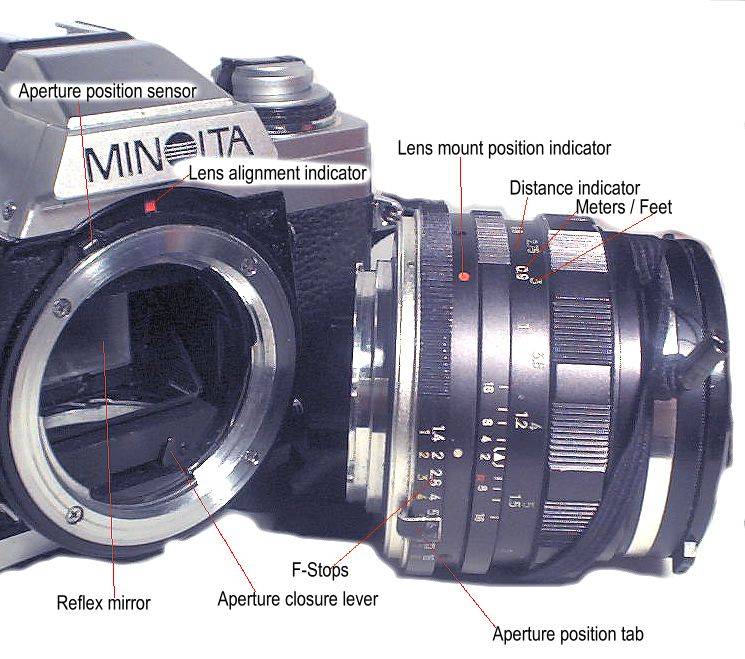
-
Here, the red dot on the side of the lens can be seen. This must be lined
up with the red indicator on the top of the lens mount when installing
or removing the lens.
-
The way the automatic exposure system works is that is senses the aperture
setting and sets the shutter speed for the proper film exposure. In order
to sense the aperture setting, the camera has a ring next to the lens mount.
This ring has a tab which contacts a tab on the lens's aperture ring. When
the aperture ring on the lens is turned, the aperture sensor ring on the
camera body turns and senses the aperture setting. The 50 mm lens
was originally from a camera (Minolta SR-3) that did not have this feature.
The metal tab was glued on so that the camera body could sense the lens's
aperture position. The Vivitar Zoom has a similar tab built into it.
-
With the lens removed, the internal parts of the camera body can be seen.
These are extremely delicate, especially the reflex mirror. This mirror
reflects the image from the camera lens into the viewfinder. When the shutter
is release, the mirror quickly flips up out of the way so that the light
can go through the shutter and hit the film. NEVER TOUCH THE REFLEX MIRROR.
This mirror has a silvered surface and is easily scratched. Fingerprints
are difficult to remove. A dirty mirror will not affect the photographs,
but will affect the image seen in the viewfinder. Don't blow on it with
your mouth to blow dust off it, as you may get spit on it. Use a blower
or canned air source for this.
-
Below and in front of the reflex mirror is the aperture closure lever.
There is a tab on the back of the lens connected to the aperture that is
controlled by this lever. This tab holds the aperture open when looking
through the viewfinder. When the shutter is pressed, the aperture closure
lever allows the aperture to close to its set point, then opens the aperture
back up again after the exposure is over.
-
Never leave the camera body open for any more than the briefest periods
of time when changing lenses. Dust can get in and affect the quality of
the pictures.
Loading Film
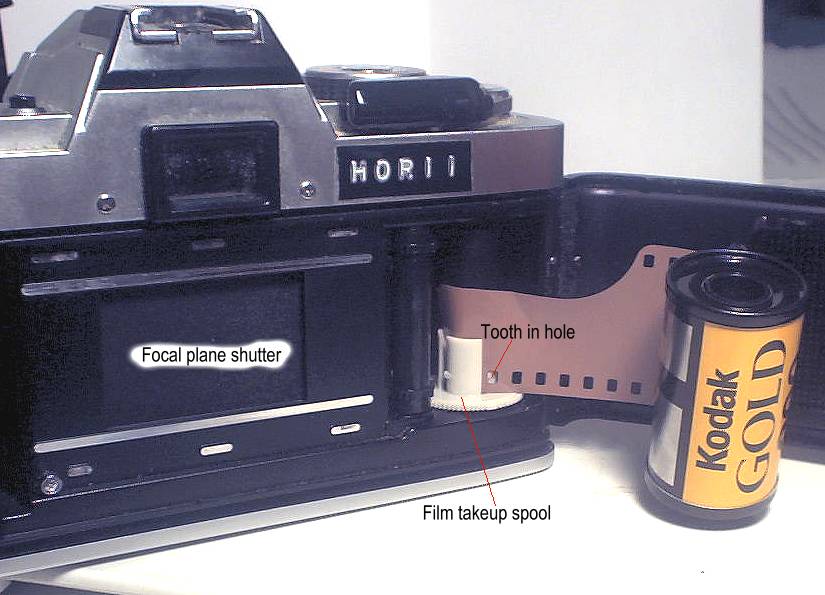
-
Film changing is a critical step that must be done carefully.
-
Lifting the Rewind knob releases the camera back and allows it to be opened.
Opening the camera back also resets the film counter.
-
To load film, put the end of the film leader into the takeup spool as shown.
The takeup spool has slots for the film and little teeth to grab onto the
film sprocket. Make sure one of the teeth is in a hole in the film sprocket.
This
is very important. If this is not done, the film can slip out of the takeup
spool and will not advance.
-
The focal plane shutter can be seen on the back of the camera. NEVER TOUCH
OR PRESS ON THE SHUTTER.
-
Next to the Film Takeup Spool is the film sprocket roller. This roller
guides the film and tells when the film is loaded properly and is moving.
It also normally prevents the film from moving backwards and being rewound.
The film Rewind Release Button releases this roller and allows it to let
the film be rewound.
-
On the camera back is the spring loaded pressure plate. This pushes on
the film to keep it flat. DO NOT TOUCH THE PRESSURE PLATE or get it dirty,
otherwise the film can be scratched.
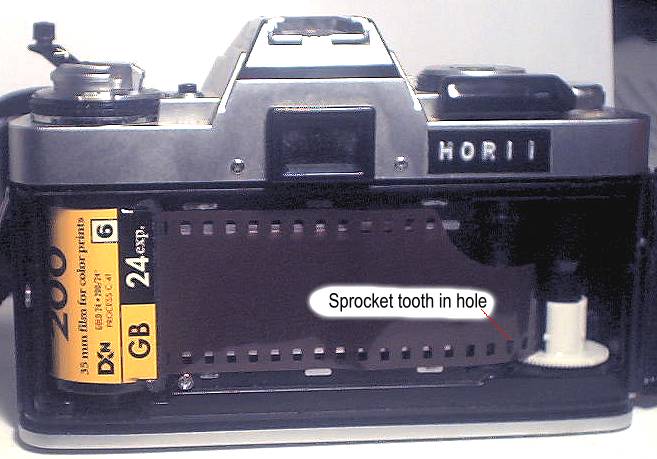
-
This shows the film properly loaded.
-
Lift up on the Rewind Knob so that the film cassette can fit in its cavity.
-
Pull the cassette across and put it in its cavity, gradually pulling out
some of the film, but not too much.
-
The film should lie flat and centered across the back of the camera.
-
A tooth on the sprocket roller should go through a sprocket hole in the
film.
-
Manually turn the takeup spool to tighten up the film.
-
Push down on the Rewind Knob and turn it slightly so that it engages the
film cassette spool.
-
Close the camera back.
-
Turn the Rewind Knob to tighten up the film.
-
Cock the shutter. Take a couple of dummy shots until '1' appears in the
film counter. While winding the film, you should see the orange bar appear
in the Film Advance Indicator and the Rewind Knob should turn. If not,
the film may have slipped out of the takeup spool, and it is not advancing.
Open up the back and reposition the film.
-
Now you are ready to take real pictures.
Zoom Lens
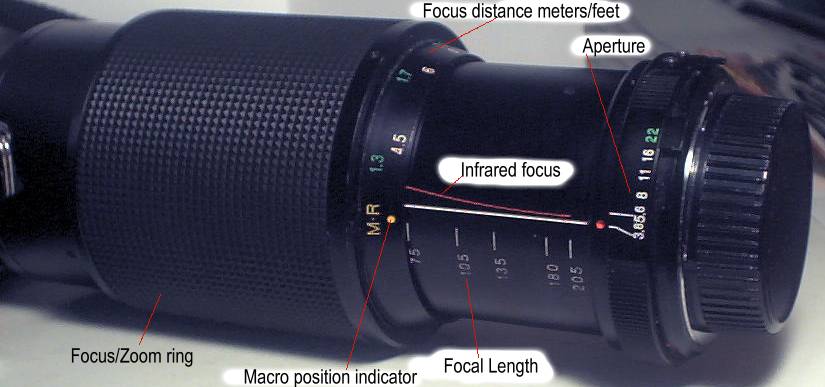
-
The Vivitar zoom lens has a single large ring for focusing and zooming.
-
The dust cap at the back end will also fit on the normal lens. When changing
lenses, transfer this dust cap to the lens that is not in use.
-
Turning the ring focuses the lens. The focus distance markers are indicated
on the zoom/focus ring in meters and feet. The white line on the barrel
points to the normal focus distance. The red line is for infrared film.
-
The M-R position is the macro position. This allows for extreme close-ups.
Move the camera forwards and backwards from the object to focus. Move the
zoom ring in and out to change the size.
-
Pushing the ring in and out changes the focal length. Pushing it out reduces
the focal length. Pulling it in increases the focal length. The minimum
focal length is 70 mm, which is a mild telephoto. The longest is 205 mm,
which is a moderate telephoto, giving a magnification of 4X the normal
lens.
-
The longer the focal length, the stronger the magnification. A 50 mm lens
is considered a normal lens and 1X magnification. Focal lengths less than
this are considered wide angle, while greater than this are considered
telephoto. The magnification factor of a lens is the ratio of its focal
length to that of a normal lens. Thus 100 mm is 2X, 200 mm is 4X, 25 mm
is 1/2X.
-
Increasing the focal length increases the magnification, but it also decreases
the depth of focus and increases the susceptibility to blurring from shaking
the camera. To compensate for this, longer focal lengths require faster
shutter speeds proportional to the the focal length. For instance, if 1/125
sec is adequate at 50 mm, you would need 1/250 sec at 100 mm and 1/500
sec at 200 mm. This also means wider lens openings, but because the zoom
lens does not have as low an f-stop as the normal lens, this may require
using a tripod at the higher focal lengths in low light or using faster
film.
-
The Aperture ring adjusts the aperture, as on the normal lens. Note that
the largest lens opening is f3.8, while the smallest is f22.
-
The front of the lens has a skylight filter. Note that this lens has a
bigger diameter than the normal lens, so filters and lens caps are not
interchangeable between the two.
-
A collapsible lens shade screws onto the front of the lens.
Caveats
-
Do not drop the camera or lenses! They are heavier, more precise,
more delicate, and much more expensive than point-and-shoot cameras. Carry
the camera and lenses in a backpack or camera bag. Be careful not to bang
it against anything.
-
Film changing should not be done in direct sunlight. If no shade is available,
use your body as shade. Keep exposed rolls of film out of the sun.
-
Dust and fingerprints are the enemies of picture quality. Keep the lens
clean. Use special lens cleaning cloths and brushes only. Do not use Kleenex.
It can scratch the lens.
-
Sand and dirty are enemies of the camera's mechanics. Be careful to keep
the camera wrapped up when shooting on windy days or at the beach.
-
Always make sure the film is winding properly. There's nothing worse than
thinking you've shot up a roll of film only to find that film wasn't winding.
-
Don't rely on the camera to set the correct exposure. Be aware of how it
can be fooled. Remember that the exposure control is center-weighted, so
only objects in the center of the screen will have the correct exposure.
When it doubt, bracket the exposure: take shots at 1 or 2 stops above and
below the automatic setting.
-
Keep an eye on the shutter speed, since it is automatically set. In low
light, the shutter speed can be too slow to take handheld pictures without
blurring. If the shutter speed goes below 1/125 of a second with the normal
lens, open the aperture up. If the aperture is already wide open, steady
the camera on a tripod or brace it against a stable surface.
-
Beware of incorrect settings: film speed, exposure adjust, and manual shutter
speed.
-
When using a flash, make sure the shutter speed is set for 1/60 sec, and
set it back to automatic when done.
Automatic Flash
-
The Vivitar automatic flash has a hot shoe connection and an optional PC
cable connection. For use with the XG-M, the PC cable is not necessary
if the flash in mounted on the camera's hot shoe.
-
The flash may be used off the camera for applications like bounce flash
or raising the flash higher to reduce red-eye. A PC cable is required.
There is a socket on the side of the flash for the PC cable.
-
The flash is automatic, which means it has a light sensor to adjust the
flash duration. The sensor detects light reflected off of nearby objects.
The more reflected light sensed, the shorter the flash. The sensor is at
the top of the front of the flash. A switch next to it moves a shutter
in front of the sensor to block it, putting the flash into manual mode.
Manual mode causes the flash to give its full flash duration each time.
-
On the side of the flash is a chart that indicates the aperture setting
for different distances and film speeds. The highlighted line indicates
the automatic flash setting. Set the aperture to this setting based on
the film speed. This setting is good up to the indicated distance. If objects
are beyond this distance, open up the aperture according to the chart.
-
The flash has an on-off switch on the back. When turned on, the flash will
make a singing noise as it charges up. When it is ready to flash, a neon
light on the back will light up. Do not attempt to use the flash until
this light is on. The flash uses 9V batteries. When the charging time is
too long, the battery needs replacing. Be sure to turn off the switch when
the flash is not in use to avoid draining the battery.
Links
Camera Hardware Info.
Photography Tutorials
Photography Info., Online Magazines
Photography Galleries, Museums
Photography Links